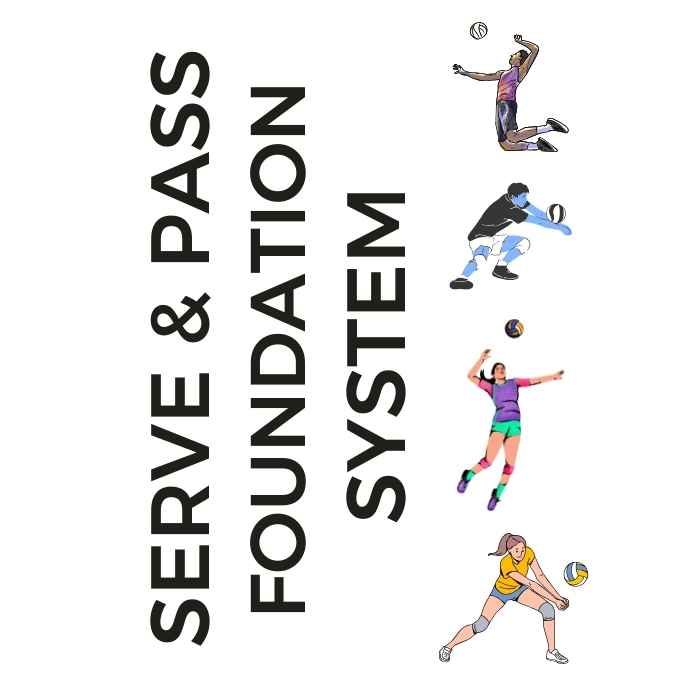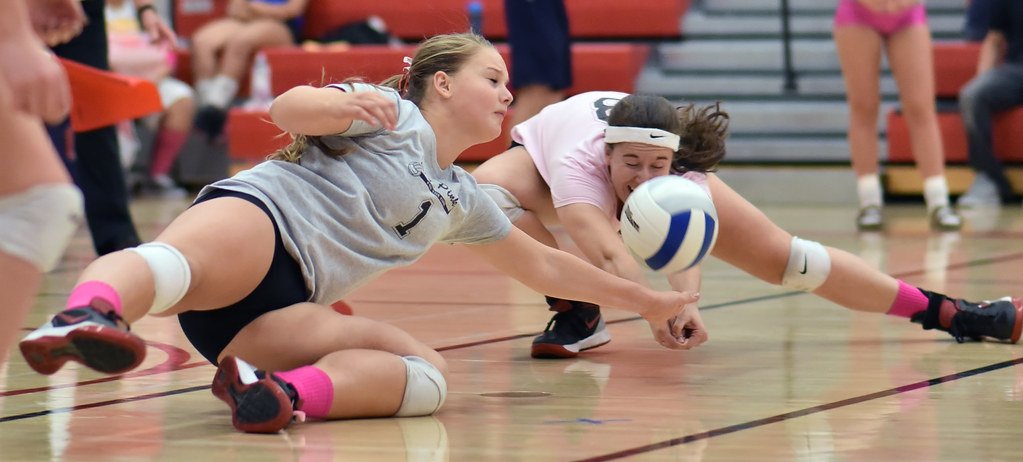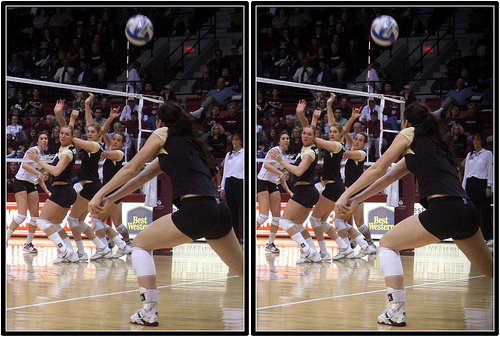
Serve + Pass Foundation System: The Complete Skills Arsenal The two-skill mastery system that transforms inconsistent players into the athletes coaches build their lineups around. Stop Struggling With The Two Most Important Skills In Volleyball!
- Improve Your Volleyball with Coach April
- Basic Volleyball Terminology.
- Dig Volleyball Definition
2 Dig Volleyball Definition Terms For Liberos and Defensive Players
The dig volleyball definition for two terms with explanations for an "up" and what "tagged" means which describe what happens in back court defense.
Here is the dig volleyball definition for two terms including explanations for
- up
- tagged
which both describe what happens in backrow defense.
Digging volleyball spikes and keeping the ball from hitting the court floor is a large part of the job description for liberos, defensive specialists and six rotation players who have to play defense in the back court.
Learning these two defensive terms will help players in these positions do there jobs even better.
The Dig Volleyball Definition
What is an "up"?
A "nice up!" is a great defensive save or dig.
It's in the same category of phrases or terms describing an incredible volleyball dig, like the term "nice lip" is.
Kenny makes a great "up" in our defensive practice during Breakfast club.
This is what players say when a teammate has been digging volleyball spikes all match has made an incredibly unbelievable dig.
An "up" comes as a result of a player who is continuously digging volleyball hits, tips and attacks that stay off the floor.
When she digs a playable ball she has dug the ball "up."
Regardless of whether you have to dive, roll, extend, sprawl or just stand in place to make great defensive saves, a nice "up" means you kept the ball from hitting your court floor.
How Do You Get The Ball "Up" In Volleyball
Proper form and movement are crucial in successfully executing an "up". Here are some tips to help you nail this defensive move:
1. Stay Low and Ready:
Keep your knees slightly bent with your arms in front of you. This ready position will help you move quickly when the opposition attacks.
2. Keep Your Eyes on the Ball:
Watch the ball from the moment it leaves the opponent's hands, and anticipate where it will go.
3. Get Behind the Ball:
Try to position yourself directly behind the ball. This gives you the greatest control when doing an up.
4. Use Both Arms:
Keep your arms together, forming a flat platform for the ball to bounce off, thereby reducing the chance of mishits.
How Do You Get "Tagged" By The Ball In Volleyball
Hey there!
There's a term in volleyball we call "tagged".
This is when a player has been hit by a ball that's been spiked from the other team. Imagine playing a game of tag, but it's the ball that tags you!
So, what does it mean for you?
Well, being "tagged" means that you just couldn't get out of the way of the ball to keep it in play. In other words, a dig didn't happen as it was supposed to.
Sometimes, you might get "tagged" if you're not ready, too surprised, or didn't read where the ball was going properly.
It's also likely to happen when you don't get to the right spot soon enough, to get under the ball and bounce it back up. Instead, the ball hits you and falls right on the ground.
Why is knowing about “tagged” important?
Because if you understand why it happens, it can be a wake-up call to start working on things like faster reactions, better reading of the opponents, getting to the right spot at the right time, and performing your digs like a pro.
Now, how do we avoid getting “tagged”?
Always watch what's happening on the other side of the net, think ahead about your next move, be ready all the time, and remember to maintain your low to the floor dig position.
This way, instead of being hit, you'll be able to avoid the ball properly when it comes your way.
Common Mistakes to Avoid When Players Get "Tagged"
Getting "tagged" frequently can be a sign that you're not positioning yourself correctly in defense. Here are some common mistakes to avoid:
1. Standing too Upright: Having your center of gravity too high can make quick defensive moves difficult. Stay lower to react swiftly.
2. Not Watching the Ball: If you're not actively watching the opponent's attack, you increase chances of getting tagged.
3. Poor Anticipation: A key aspect of a good defense is anticipation. Understanding the opposition's tactics and adapting your position can decrease the likelihood of being tagged.
Remember, mastering these moves requires practice and patience, so devote time to repetitive drills and match-play to enhance these crucial skills.
Quiz Time! Test Your Skills: Interactive Volleyball Quiz Section
Ready to test how well you understood the topic of "Dig Volleyball Definition"?
Try this 12-question quiz focusing on the key points and practical tips covered in our discussion.
Whether you are a player starting your volleyball journey or a seasoned pro, this quick quiz is a fun way to test your knowledge!
1. What does being 'tagged' mean in volleyball?
a) Serving the ball successfully
b) Being hit by the ball from an attack
c) Scoring a point
d) Blocking an attack
2. True or False: "Tagged" in volleyball refers to the successful execution of a dig?
3. What is the term when you successfully save a ball from hitting the court floor in volleyball?
a) Smash
b) Tag
c) Up
d) Serve
4. Which of these is not a cause for getting 'tagged'?
a) Not being in the correct stance
b) Properly reading the trajectory of the ball
c) Being caught off guard
d) Not positioning oneself effectively
5. Which of these signifies an unsuccessful attempt at a dig?
a) Smash
b) Tagged
c) Serve
d) Block
6. True or False: To prevent getting 'tagged', a player must maintain the ready position and have correct body posture.
7. When a player continues to dig the ball keeping it from hitting the court floor consecutively, they are said to have done what?
a) Tagged
b) Up
c) Smash
d) Serve
8. Being ‘tagged’ often indicates the need to work on:
a) Spiking power
b) Serving consistency
c) Response time and positioning
d) Celebratory dance moves
9. True or False: A tag only occurs when a player fails to serve correctly.
10. What should players consistently watch to prevent being tagged?
a) The audience
b) Other teammates
c) The Coach
d) The opponent’s side
11. What does a "nice up" indicates in volleyball?
a) A successful serve
b) A successful defensive save or dig
c) A successful block
d) A successful attack
12. True or False: An "up" comes regardless of whether you have to dive, roll, extend, sprawl or just stand in place to make great defensive saves.
Remember, whether you got all the answers right or there were a few you weren't sure about, the most important thing is that you're learning and having fun.
Challenge your friends to complete the quiz and see who knows the most about volleyball defense strategies!
Keep practicing, and keep digging deep into the thrilling world of volleyball.
Quiz Answer Key:
1: b - Being hit by the ball from an attack
2: False
3: c - Up
4: b - Properly reading the trajectory of the ball
5: b - Tagged
6: True
7: b - Up
8: c - Response time and positioning
9: False
10: d - The opponent’s side
11: b - A successful defensive save or dig
12: True
Remember, whether you answered all correctly or missed a few, the most important thing is that you're learning and having fun!
Share this quiz with your friends and teammates, and see who knows the most about volleyball digs!
Keep practicing and keep digging deeper into the fascinating world of volleyball.
Do You Follow Me on Pinterest?
Follow me on Pinterest Volleybragswag to improve your game even faster!
I share alot of individual, partner and easy-to-do volleyball serving drills we do in class with my followers.
Many of these volleyball practice drills you can do at home by yourself or try at your next practice with your teammates.
If you're a B team or JV player trying to make varsity next year...your goal should be to complete 1000 reps a day of at least three of the basic skills on your own...volleyball passing, serving and setting should be at the top of the list.
Dig Volleyball Definition. Good times!
Where do you need to go now?
- Learn more about the volleyball words, terms and terminology in the Related Links below.
- Follow the suggested reading on our Sitemap page Learning How To Play (Sitemap)
- Or visit the pages in the Information section in the drop down menu at the top of the page.
If your athlete struggles with consistent serve receive, gets subbed out, or is overlooked for playing time—this is the fix you’ve been looking for.

Struggling with passing consistency?
I help talented passers tired of getting pulled from games because of inconsistent serve receive skills BUILD passing confidence without expensive private lessons using the same 3-step system that's helped dozens of my athletes get recruited.
Download my eBook for $17.99 and start building the passing confidence that keeps you on the court—and gets you seen by college coaches.
From Lady Vol to Legend: Coach April Produces Powerful Passionate Players...is that you?
What Are You Looking For?
Click to Download Your Pre Serving Ritual Mastery Checklist pdf:
🎯Volleyball Pre Serving Ritual Guide -
Players! Learn How To Transform Your Serve from Weak to Weapon
Click to Download Your Parent's Volleyball Serving Checklist pdf
🎯Parent's Volleyball Serving Checklist Guide
Parents! Help Your Player Develop Championship Serves (Even If You've Never Played)

Hi there!
Thanks for stopping by. Hope you learned something today that will help you reach your volleyball goals.
Be sure to subscribe to my email newsletter so you can learn more each week!
Stay strong! Stay motivated!
-Coach April

SUSCRIBE to my email newsletter below!
 Click to learn more about the weekly volleyball classes and clinics or email info@imrpoveyourvolley.com for information
Click to learn more about the weekly volleyball classes and clinics or email info@imrpoveyourvolley.com for informationCongratulations to my seven Boys-18s Vegas Volley club players who played in two state championship finals yesterday, the 3A and 5A State champinship finals at Sunrise Mountain High School.
TOURNAMENT CHAMPIONS!
A-1 Vegas Volley VBC
In It To Win It Tournament
May 2 - 4, 2025 Tournament
Gold Medalists
18s Premier Division
Vegas Volleyball's Unsung Heroes: Celebrating Moms with Peace Love Volleyball Shirts
Ready to energize your volleyball mom journey?
Subscribe to my 'Producing Powerful Passionate Peaceful Players' email list above on ImproveYourVolley.com.
You'll receive energy-boosting tips, exclusive insights from me, Coach April Chapple on maintaining momentum in volleyball.
Let's power up the Vegas volleyball scene together!
Recent Articles
-
12 Drills To Improve Volleyball Skills:Complete Practice Drill Library
Dec 27, 25 12:23 PM
Master these 12+ proven drills to improve volleyball skills with step-by-step instructions for passing, setting, serving, hitting, blocking and defense. -
Workouts To Improve Volleyball Skills: 4-Week Training Plan & Tracker
Dec 26, 25 10:04 PM
Get complete structured 4-week workouts to improve volleyball skills with daily training schedules, self-assessment checklists, and progress tracking. -
How To Practice Volleyball Alone: Solo Drills That Build Real Skills
Dec 26, 25 06:20 PM
Learn how to practice volleyball alone with wall drills, progressions and weekly one-player training schedules to improve passing, setting, serving & hitting.



















































